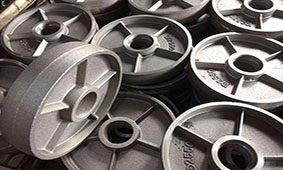
Formaldehyde emission limits: HA offers solutions for the Cold-Box sector

In December 2015, the Federal/State Working Group (LAI) issued its recommendations on limiting formaldehyde emissions. The tightened limit values laid down therein affect general operating permits for plants. With the expiry of a transitional period, these limit values will also apply to older plants from February 2020 onwards. For the foundry industry, the lowest limit values apply according to these recommendations.
Today’s HA Cold-Box system no longer contain any free formaldehyde. This means that the stricter limit, which will see the volume of permitted formaldehyde emissions cut from 20mg/m³ to 5mg/m³, does not represent a problem in most process steps. Under certain conditions, however, formaldehyde can split off from the finished core.
This happens mainly as coated cores are cured in gas ovens. Depending on various influencing factors, such as temperature, core geometry, air humidity and flow velocity, the new exhaust air limit of 5mg/m³ could pose a problem for a number of existing plants. There are a range of technical solutions for reducing emissions from plant equipment. However, these measures frequently involve higher building and technical licensing efforts as well as capital expenditure.
In order to meet the challenge of complying with the substantially reduced limits for formaldehyde emissions, HA, as a specialist for foundry chemistry, already offers its customers Cold-Box binders, coatings and additives that are specially tailored to their foundry-specific needs and actively bind formaldehyde and thus neutralise emissions.
With the opening of the HA Center of Competence (CoC) in Baddeckenstedt in 2017, HA is in an even better position to test special applications on a practical scale outside the laboratory in order to develop new products and customise existing products for customers’ specific processes. In addition to classic core and mould manufacturing processes, the CoC’s facilities also include systems for a wide variety of other foundry processes, including robot-assisted sizing, core drying, melting units and casting lines, as well as modern manufacturing techniques such as 3D printing. HA uses these technical possibilities to develop solutions for tomorrow’s challenges together with its customers, and to offer a wide range of products for individual requirements.



Trump weighs using $2 billion in CHIPS Act funding for critical minerals

Codelco cuts 2025 copper forecast after El Teniente mine collapse

Electra converts debt, launches $30M raise to jumpstart stalled cobalt refinery

Barrick’s Reko Diq in line for $410M ADB backing

Abcourt readies Sleeping Giant mill to pour first gold since 2014

Nevada army depot to serve as base for first US strategic minerals stockpile

SQM boosts lithium supply plans as prices flick higher

Viridis unveils 200Mt initial reserve for Brazil rare earth project

Tailings could meet much of US critical mineral demand – study

Kyrgyzstan kicks off underground gold mining at Kumtor

Kyrgyzstan kicks off underground gold mining at Kumtor

KoBold Metals granted lithium exploration rights in Congo

Freeport Indonesia to wrap up Gresik plant repairs by early September

Energy Fuels soars on Vulcan Elements partnership

Northern Dynasty sticks to proposal in battle to lift Pebble mine veto

Giustra-backed mining firm teams up with informal miners in Colombia

Critical Metals signs agreement to supply rare earth to US government-funded facility

China extends rare earth controls to imported material

Galan Lithium proceeds with $13M financing for Argentina project

Kyrgyzstan kicks off underground gold mining at Kumtor

Freeport Indonesia to wrap up Gresik plant repairs by early September

Energy Fuels soars on Vulcan Elements partnership

Northern Dynasty sticks to proposal in battle to lift Pebble mine veto

Giustra-backed mining firm teams up with informal miners in Colombia

Critical Metals signs agreement to supply rare earth to US government-funded facility

China extends rare earth controls to imported material

Galan Lithium proceeds with $13M financing for Argentina project

Silver price touches $39 as market weighs rate cut outlook

















